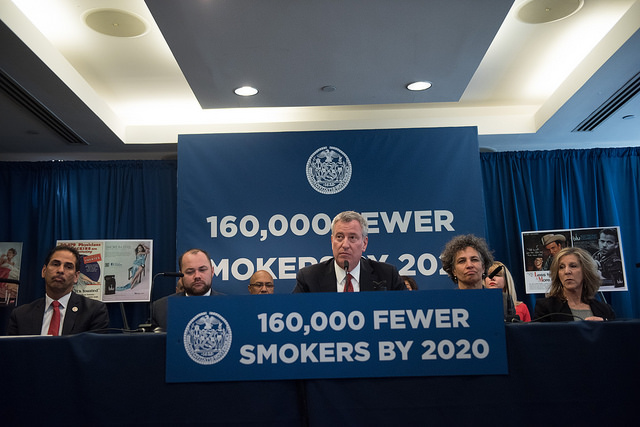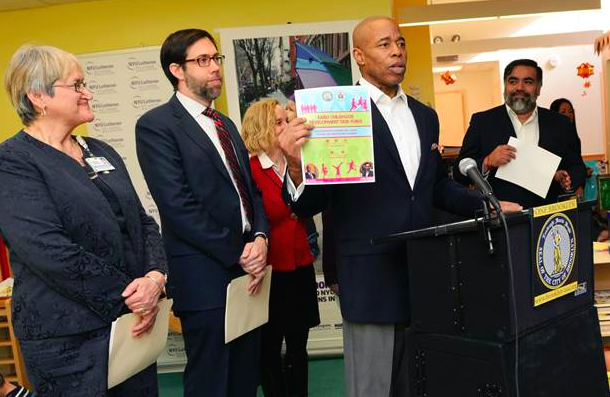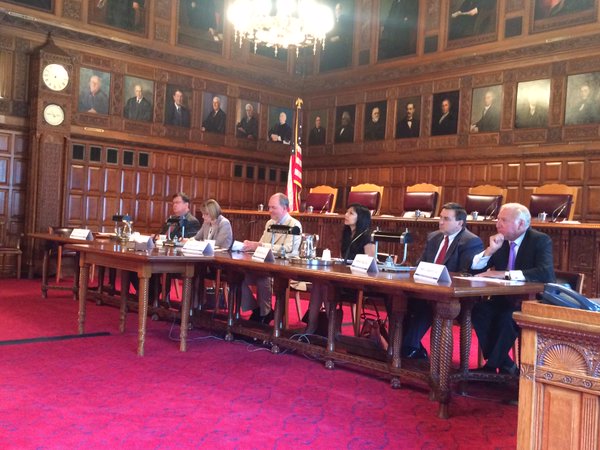Bills Fight Smoking by Keeping Pace with Tobacco Companies

Mayor de Blasio & co. (photo: Michael Appleton/Mayor's Office)
Thanks to aggressive policies and programs over the past decade, the adult smoking rate declined significantly in New York City, from 21.5% in 2002 to 14.0% in 2010. However, to maintain these gains we need to continue to update our tobacco control policies to respond to an ever-changing market where tobacco company strategy attempts to circumvent current regulations.
As a physician whose primary practice involves helping New Yorkers quit smoking, I strongly support the four bills proposed by New York City Mayor Bill de Blasio and City Council members to strengthen the city’s tobacco control policies.
I have seen firsthand the many challenges smokers face when trying to quit. On top of the addictive properties of tobacco products, New Yorkers who smoke are faced with a retail environment that creates cues to smoke on every corner. The widespread availability of tobacco products in retail outlets, along with extensive marketing at the retail point-of-sale, is designed to attract new tobacco users, discourage quitting and create a normative environment that makes tobacco use acceptable and even makes it desirable. To reduce smoking, we cannot simply focus on the individual smoker: we must also change an environment that encourages young people to initiate tobacco use and blocks efforts by smokers to quit. This package of bills moves New York City closer to that goal.
Individually, each of these bills represents an effective method for addressing gaps in current policies. Implemented together, they represent a powerful, comprehensive and synergistic approach to addressing multiple aspects of the retail environment that undermine tobacco tax policy and create environmental triggers to smoke.
One bill would limit new licenses to sell tobacco products, setting caps for retail outlets to sell tobacco products in community districts. It responds to strong evidence that a high-density retail environment in residential neighborhoods is associated with recent initiation of tobacco use among young adults and greater difficulty quitting among smokers.
Another bill in the package prohibits pharmacies or retail stores that contain pharmacies from selling cigarettes and electronic cigarettes, which will act synergistically with the previous bill to further reduce retail density. In 2014, CVS led the way in ending the sale of cigarettes and tobacco products saying that it was “inconsistent with our purpose – helping people on their path to better health.” Although an important step, other national chains have not adopted this policy, creating the need for government action.
There is precedent and evidence supporting the pharmacy ban. Other cities have already passed similar bills—backed by high levels of public support—and subsequent studies demonstrated the link between these bans and reduced retail density in communities.
Finally, the proposal to establish price floors for cigarette packages, other tobacco products and non-tobacco shisha, and to establish taxes on previously untaxed tobacco products, will reduce the likelihood that smokers switch from cigarettes to cheaper products. This will create a tax and price environment that will reduce youth initiation of tobacco use and encourage people to quit.
Unfortunately, the tobacco epidemic is not static. New products are introduced at an alarming rate, the tobacco industry continues to look for loopholes to circumvent tobacco policies, and sometimes policies have unintended consequences that need to be remedied. To continue to achieve our prevention and cessation goals, we must be proactive and keep pace with this changing environment by introducing new laws to fill gaps in current policies, particularly when the evidence points us in the right direction.
The evidence-based policy package put forth by Mayor de Blasio and City Council members represents a tremendous step forward for New York City’s efforts to meet the National Healthy People 2020 goal of 12% smoking prevalence and, most importantly, will prevent individuals—especially young people—from picking up a habit that is much easier to start than to stop.
***
Donna Shelley, MD, MPH is an associate professor of Medicine and Population Health at NYU School of Medicine and leads the smoking cessation service at NYU Langone Medical Center’s Laura & Isaac Perlmutter Cancer Center and directs NYC Treats Tobacco, which helps healthcare organizations help their patients quit. Dr. Shelley has conducted research on health disparities related to tobacco use for over 15 years.
***
Have an op-ed idea or submission for Gotham Gazette? Email This email address is being protected from spambots. You need JavaScript enabled to view it.
The Smart Path Forward in Early Childhood Education

the authors: Eric Adams, at podium, & Daniel Squadron, to his right (Erica Sherman/Brooklyn BP's Office)
In April, Mayor de Blasio announced a new initiative aimed at closing the gap in early childhood education, 3-K for All. The rollout, beginning in historically under-resourced communities like Brownsville and the South Bronx, is projected to provide a seat for every three-year-old living in those parts of the city by fall 2018 – some 1,800 kids. This big step on the road to expanding early childhood development programming across the city is a culmination of years of research and advocacy from civic organizations, community leaders, and think tanks.
Our city is and always has been a place of immense opportunities for academic enrichment, personal fulfillment, and prosperity. But for too long, and for too many, those possibilities have remained out of reach. Unfortunately, disparities begin early in life – and often even before birth.
Research has shown that 90 percent of physical brain development occurs in the first three years of life, and cognitive studies demonstrate the lasting impact of sustained investment in infants’ emotional, mental, and social development. There is also strong evidence that children in home visiting and early childhood programs have decreased criminal justice system involvement, teenage pregnancy rates, special education needs, and social safety net service utilization; with increased high school success and college attendance, as well as maternal employment rates and income. Not only can early childhood investments lead to decreased public expenditure on social services -- they can actually result in increased tax revenues later in life too.
In 2015, we jointly launched the Early Childhood Development Task Force. The Task Force comprised a broad coalition of advocates, community stakeholders, and local hospitals, with an aim to promote the healthy growth of Brooklyn’s youngest, along with their families, as well as help expand existing evidence-based development programs. Partners such as Healthy Families New York (HFNY), Nurse-Family Partnership (NFP), Parents-as-Teachers (PAT), and the Parent-Child Home Program (PCHP) shared crucial information, including difficulties in sharing service information and increasing utilization, especially in many target neighborhoods.
Our findings, released in February of this year, demonstrate the impact of early life interventions on school readiness, emotional and social development, family health, economic growth, and public safety. The evidence is clear: engaging mothers before they give birth through the most formative years results in positive impacts on children’s lives. But to realize the litany of benefits, increased investment and information sharing is critical.
It is crucial that all parents receive information on the availability of resources in their own communities. A multilingual campaign to empower communities with increased information, including resource guides of early childhood services available for parents and guardians and online maps and tools to provide data on nursery and pre-K seat availability in communities where there are an abundance of seats but low participation rates would all be important steps.
In addition, targeted workshops for community leaders including local clergy can help engage and inform hard-to-reach communities about resources available to parents. And, the truth is, this is one area where increased investment should be an easy sell -- since it will more than pay for itself, in lives improved and dollars saved.
3-K for All moves us in the right direction, but we must be even more ambitious about delivering comprehensive early childhood development. We must offer universal services to eligible families before a child is born -- and then continue them from birth to 3-K and onward. This is how we will make the biggest difference for families, not just in their first years of school, but all the way to college, career and beyond.
***
Eric Adams currently serves as Brooklyn’s Borough President. Daniel Squadron currently serves as State Senator for the 26th District covering the Brooklyn Waterfront and Lower Manhattan. On Twitter @BPEricAdams and @DanielSquadron.
***
Have an op-ed idea or submission for Gotham Gazette? Email This email address is being protected from spambots. You need JavaScript enabled to view it.
New York’s Asbestos Courts Need Transparency

(photo: @NYSCourtsNews)
New York’s asbestos litigation system is broken.
Currently, a procedural loophole in the state’s laws allows a few politically-connected law firms to game the courts and win themselves massive attorneys’ fees by manipulating the truth of their clients’ exposure to asbestos -- intentionally misleading courts and bankruptcy trusts by obscuring the truth.
When a victim of asbestos exposure decides to seek compensation, they can file claims in civil court against the companies they deem responsible, and also seek compensation from the trusts established to handle claims for asbestos manufacturers which have filed for bankruptcy. In theory, the system allows these claimants to be appropriately compensated by all the parties responsible for their exposure.
In practice, however, some lawyers will first file a civil complaint in which they claim a specific company or group of companies are solely responsible for their client’s exposure to asbestos. Once that civil case is concluded – a process that generally takes at least six months and can potentially go on for years – the lawyers often then file multiple bankruptcy trust claims, which present completely new and contradictory claims asserting that multiple bankrupt companies are responsible for their clients’ exposure.
This practice allows lawyers to punish companies in court by placing the full burden of victims’ exposure on a single manufacturer, when in reality, the lawyers know that many other companies were also responsible.
By changing the facts of their claims once the civil portion of the process ends, lawyers are defrauding the bankruptcy trusts and enriching themselves with additional legal fees. The practice obscures the full evidence of the case from the courts and defendants alike, and abuses a system established to fairly and justly offer recompense for victims of asbestos exposure.
No lawyer should be able to falsify the facts of a case simply to line their own pockets, and a legislative remedy to this problem is desperately needed.
Right now, a bill before the New York State Legislature offers a clear solution. Under the Truth, Fairness, and Transparency in Asbestos Litigation Act, all bankruptcy trust claims would be required to be filed within 45 days of the start of any civil action, taking away the opportunity for lawyers to make one claim in court and then present an entirely different story months or years later.
A dozen other states have already beaten New York across the finish line in battling this dishonest practice, including three in just the past year alone. Closing this loophole accelerates compensation for the victims of asbestos exposure, and prevents the fraudulent and blatantly inappropriate misuse of a system designed to help suffering victims and their families.
As quoted by the sponsors of the bill in New York, a federal judge called the use of this practice an “infection” within the legal system, which represents an intentional effort to suppress and obscure evidence during the legal proceedings. Efforts to pass the bill are supported by veterans, lawmakers, business groups, and more, including former judges and lawyers who witnessed these abuses firsthand.
Our legal system is intended to protect all New Yorkers, and to administer justice appropriately and in accordance with the facts of any given case. It’s time for our laws to change and force transparency and honesty into this system, and end this dishonest and indefensible practice.
***
Peggy Ableman is a former judge on the Superior Court of the State of Delaware, with 30 years of experience on the bench. During her tenure on the Superior Court, Judge Ableman presided over the state’s asbestos litigation docket, presiding over more than 500 cases.
***
Have an op-ed idea or submission for Gotham Gazette? Email This email address is being protected from spambots. You need JavaScript enabled to view it.




